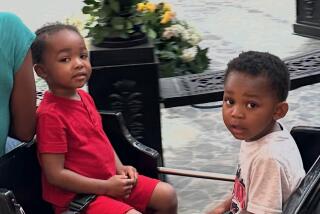Septuplets Born to Teacher, 30; 6 Cling to Life
A 30-year-old Riverside schoolteacher gave birth to septuplets at a hospital in Orange Tuesday morning, but the last of the seven was stillborn. The six tiny surviving infants, all delivered by Caesarean section, were listed in critical but stable condition and were doing well for their size, spokesmen said.
Patti Frustaci delivered the four boys and three girls within three minutes, beginning at 8:19 a.m., at St. Joseph Hospital, hospital spokesmen said.
The seventh baby, a girl, apparently died in the uterus several days ago, said Dr. Martin Feldman, Frustaciâs obstetrician and the head of the 38-member delivery team.
All on Respirators
Five of the six ranged in size from 1 1/2 pounds to 1 pound, 13 ounces. The sixth, a boy, was significantly smaller at 1 pound, 1 ounce.
All the babies are on respirators to assist their breathing, doctors said. The infants suffer from hyaline membrane disease, a lung affliction common among premature infants, in which there is an absence of a sticky substance known as âsurfactantâ that prevents the lungs from collapsing on themselves.
âThey are in critical condition and we will fight for each baby. It will be a rocky course for the next few weeks and months,â said Dr. Ragnar Amlie, one of the delivery teamâs seven neonatalogists, doctors who specialize in premature and critically ill infants.
Smooth Delivery
Amlie said the delivery âwent very smoothly . . . with no hitch at all.â Feldman said he was so busy during the delivery, âI donât think I was feeling anything.â But he characterized the day as âvery exciting, a once-in-a-lifetime experience.â
Patti Frustaci, who conceived the septuplets after taking a fertility drug, was listed in good condition. She gave birth two days into her 29th week of pregnancy. A normal, uncomplicated pregnancy lasts 40 weeks.
The babiesâ father, Samuel Frustaci, an industrial equipment salesman for a Buena Park firm, appeared relaxed at a press conference after the delivery.
âI was real excited after the first one came out,â said Frustaci, 32, who was with his wife in the delivery room. He said that he and his wife âfeel fortunate that we have been chosenâ for the multiple births. âI hope and pray they come out OK,â he said.
Frustaci said he was allowed to hold the seventh baby and had a moment alone with the stillborn child, as did his wife after she came out of the general anesthesia.
âItâs something only a parent can relate to. But it was rewarding because it was evidence for us to see that we did actually witness the birth of seven children. It was a unique experience,â he said. âTo see this baby who died, I think we see that it gave its life for the other six. Itâs as precious as the other six for her (Patti). This baby will always be with us and always will have a special place in our hearts.â
Had all seven survived, it would have been a record. The Guinness Book of World Records lists three cases in which sextuplets (six babies) have survived.
About 10 minutes after delivery, the babies were transferred through a tunnel that connects St. Joseph to Childrens Hospital of Orange County. Childrens has a licensed neonatal intensive care unit.
All six have tubes down their breathing passages and are on respirators to assist their breathing. The air they are receiving ranges from 60% to 100% oxygen--normal air contains about 20% oxygen--but all are capable of breathing on their own, according to Dr. Carrie C. Worcester, director of the neonatal intensive care unit.
They are moving their arms and legs, Worcester said, adding, âThese little babies are full of energy and moving appropriately.â
â50-50 or Betterâ
Worcester estimated each babyâs survival chances at â50-50 or better.â
The smallest baby received an immediate blood transfusion because his color was poor, and Worcester said several more later received transfusions because of low blood pressure. They are receiving intravenous fluids, including antibiotics, Worcester said.
âTheyâre very pink, very small and very thin,â said Doug Wood, Childrens Hospital director of community relations. He said the color indicated the babies have good circulation.
The smallest child, he said, was so tiny one could âeasily hold it in one hand.â
A videotape taken inside the neonatal unit showed six dark-haired babies lying in incubators, with a web of tubes extending from their tiny bodies.
âThe babies are beautiful. I think they all look like Frustacis,â Betty Frustaci, the infantsâ paternal grandmother, said with a laugh. âThat girl (Patti Frustaci) deserves everything the good Lord gives her.â
Patti Frustaci, a high school English teacher, had been taking the fertility drug Perganol for three months last fall before conceiving the septuplets. She had been hospitalized since March 25 so that her condition could be closely monitored, Feldman said. He had planned to delay the delivery as long as possible, but he scheduled the surgery for Tuesday because complications began to set in, he said.
Two weeks ago, Frustaciâs blood pressure began to increase and became severely elevated in the last few days, he said. The size of Frustaciâs abdomen had âincreased so enormouslyâ that she was having problems breathing, he said.
âI felt we had little to gain and a lot to lose by delaying the delivery,â Feldman said.
Hypertension, or high blood pressure, he said, causes the blood vessels to constrict and that decreases the flow of nutrients to the placenta, âthe babyâs lifeline,â he said.
The babies were crowded in the uterus, with the sixth and seventh babies located on top, under the motherâs diaphragm, Feldman said.
The seventh baby died because of the hypertension, he said. The sixth, and tiniest, baby had a small umbilical cord, he added.
âIf we had waited any longer, we possibly would have lost another one,â Feldman said.
In addition to the neonatalogists, there was a nurse and respiratory therapist on hand for each baby, as well as a team of doctors and nurses that tended to Patti Frustaci, hospital spokesmen said.
The surgery began at 8:17 a.m., according to Childrens Hospital spokesman Wood.
He said the first baby, temporarily named Baby A, was a girl weighing 1 pound, 11 ounces, and was delivered at 8:19.
At 8:20, Baby B, a boy weighing 1 pound, 8 ounces, was delivered.
He was followed seconds later by Baby C, a 1-pound, 13-ounce boy, and Baby D, a girl weighing 1 pound, 12 ounces.
Baby E, born at 8:21, was a 1-pound, 13-ounce boy.
Baby F, also born at 8:21, was the 1-pound, 1-ounce boy, promptly dubbed âthe little peanutâ by Dr. Worcester. The stillborn baby girl was delivered last, at 8:22.
Wood said that according to national surveys, newborns weighing less than two pounds have a survival rate of 35% to 40%, somewhat less than the chances given the Frustaci infants.
St. Joseph spokeswoman Debra Conkey said Frustaci would be kept in the hospitalâs intensive care unit âas a precaution,â but should be able to leave the hospital in three to five days. She will not be able to visit the children until she is out of intensive care.
The Frustacis have a 1-year-old son, who also was conceived after Patti Frustaci took Perganol. He was born without complications.
âNot Todayâ
Asked if the family planned on having more children, Samuel Frustaci replied with a grin: âNot today.â
Frustaci said he almost missed the delivery. He got onto the Riverside Freeway at 6 a.m., figuring that the freeway would be clear and that he could easily reach the hospital by 7 a.m. But the freeway was jammed âbumper to bumper,â he said. Rationalizing that it was an emergency, he turned on the carâs emergency flashers and sped all the way down the emergency lane, he said.
Asked how fast he was going, Frustaci deadpanned: âAt least 55, maybe 60.â
When the talk turned to finances, Frustaci replied: âWhat finances? You never have any money problems if you never have any money.â
The familyâs attorney, Andrew Wallet of Beverly Hills, said he will negotiate to sell exclusive rights to the Frustacisâ story, and he already has received several offers from publications.
He has established a trust fund for the Frustaci babies and will seek commercial sponsors from such businesses as baby food, clothing and diaper manufacturers, he said.
High Costs
âThe interest is the Frustacisâ financial need,â he said. The cost of raising the babies will be âastronomical,â he said. âIt will be a major expense . . . just for their diapers.â
The marketability of the Frustaci babies might rest in part on how many survive, he said.
âTheir value is dependent on what happens. . . . And whoever wants the most rights has to come up with the most dollars,â Wallet said. He would not name a figure. âThat may sound mercenary, but I guess thatâs what lawyers are known for.â
According to Guinness records and hospital officials, the largest recorded multiple birth was nine babies in Sydney, Australia, in 1971. None survived more than six days.
Guinness lists three cases in which sextuplets (six babies) survived: In Cape Town, South Africa, in 1974; in Florence, Italy, in 1980, and in Liverpool, England, in 1983.
In the case of septuplets, there is no known case where all the infants survived.
The statistical occurrence of natural conception of septuplets is one in 500 trillion, but no statistics are available on such occurrences when the parents have been aided by fertility drugs, hospital officials said.
More to Read
Sign up for Essential California
The most important California stories and recommendations in your inbox every morning.
You may occasionally receive promotional content from the Los Angeles Times.










